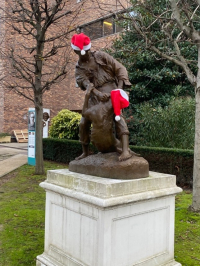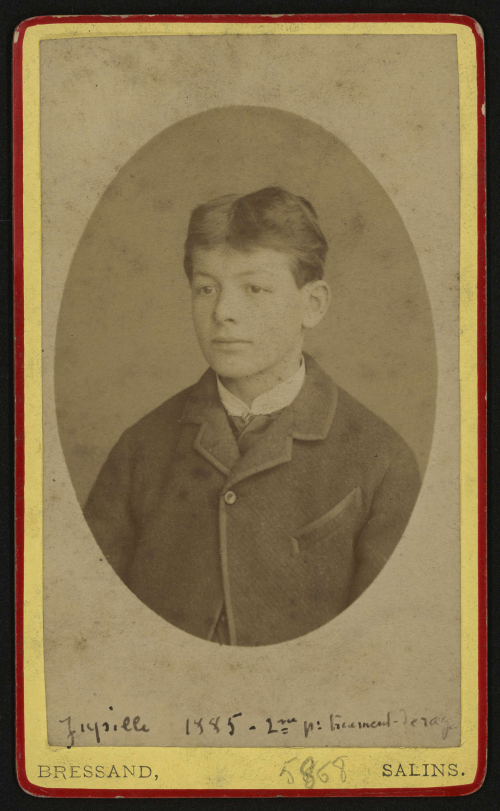
 Museum
Museum
Jean-Baptiste Jupille, the second human successfully vaccinated against rabies in October 1885
On campus, between the entrance point at 25 rue du Docteur Roux and the Metchnikoff building, you have probably noticed the sculpture of Jean-Baptiste Jupille, the 15-year-old shepherd bitten by a rabid dog in October 1885 and vaccinated by Louis Pasteur, exactly 140 years ago.
This is his story.
CA young shepherd boy named François Jean-Baptiste Jupille, born on November 30, 1869 in Port-Lesney, by the Jura mountains, entered the history books for his bravery and role in demonstrating the effectiveness of the rabies vaccine developed by Louis Pasteur.
A heroic act in Villers-Farlay
On October 14, 1885, in Villers-Farlay, the young shepherd, aged just 15, was bitten several times by a rabid dog as he tried to protect six other young shepherds. Pasteur spoke about the courage shown by the boy in his presentation to the French Academy of Sciences on October 26, 1885:
"The Academy will not fail to be moved by the story of the bravery and presence of mind of the child who I treated last Tuesday. This 15-year-old shepherd boy, named Jean-Baptiste Jupille, from Villers-Farlay in the Jura, on seeing a large dog behaving suspiciously and about to attack a group of six young shepherds, all younger than him, tackled the animal himself, brandishing his whip. The dog sank its teeth into Jupille's left hand. Jupille brought the dog down, holding it under his weight, prized its mouth open with his right hand to free his left hand – being bitten several more times in the process –, then used his whip to muzzle the dog and knocked it unconscious with one of his shoes."
Second rabies vaccination performed successfully
Realizing how serious the accident was, the mayor of Villers-Farlay, Pierre Joseph Perrot, who had heard about the success of Joseph Meister's vaccination in July, immediately wrote to Louis Pasteur, whom he had met in Arbois. A collection was held in the village of Villers-Farlay to pay for the train ticket to Paris.
The prognosis for Jean-Baptiste Jupille, who had been bitten six days before arriving in Paris, seemed less favorable than that of Joseph Meister. But Louis Pasteur agreed to treat him and provided him with a bedroom next to his laboratory at 14 rue Vauquelin.
LThe treatment began on October 20, 1885 and lasted until October 29, 1885. Ten days after being vaccinated, Jean-Baptiste Jupille seemed to be out of danger, and he traveled back to the Jura in early November. Louis Pasteur, satisfied with the success of the procedure, declared that "Jupille's health leaves nothing to be desired." Jean-Baptiste became the second human to be successfully vaccinated after a bite from a rabid animal.
Recognition and global impact
Louis Pasteur told the story of Jupille's successful treatment on October 26, 1885, at the Academy of Sciences. The news traveled around the world, consolidating the reputation of Pasteur and his vaccine.
Following a proposal from Baron Félix Larrey, the Académie Française awarded Jean-Baptiste Jupille the Montyon Prize for "courage," worth 1,000 francs and awarded in recognition of a heroic act by a poor French person. The Victims of Duty Fund also gave him a savings account containing 200 francs.
A life serving the Institut Pasteur
In 1890, Jean-Baptiste Jupille, still immensely grateful to Louis Pasteur, joined the Institut Pasteur at the age of 21. He held successive roles, including errand boy and laboratory assistant, before becoming a caretaker and eventually chief warden of the Institut Pasteur. There he met Joseph Meister, the latter also becoming a warden at the Institut Pasteur in 1913. He died in 1923.


The Jupille family's involvement with the Institut Pasteur did not stop there. Jean-Baptiste's brothers, Émile Jupille and Jean Frédéric Jupille, also worked at the Institut Pasteur, the latter as a nurse in the Rabies Department. Jean Frédéric Jupille is even credited with taking part in a rabies vaccination campaign in Cairo and working in the Tuberculosis Department. Two of Jean-Baptiste's children, Émile Florentin and Louise, known as Olga, also worked as laboratory assistants at the Institut Pasteur. Louise (Olga) spent her entire working life at the Institut Pasteur, working with professors Legroux, Calmette and Guérin, and received a silver medal on the 50th anniversary of the vaccine in 1935.
Jean-Baptiste Jupille's bravery is immortalized in two works of art:
- A bronze sculpture by Émile-Louis Truffot (1843-1895), displayed in the grounds of the Institut Pasteur. The museum has a smaller version, currently on display at the Villa du Temps retrouvé in Cabourg as part of the exhibition "Louis Pasteur, the art of science".

- The scene is also depicted on the first mosaic on the vault of the burial crypt of Louis and Marie Pasteur, created by Charles-Louis Girault

Jupille featured on a five-franc note issued in 1966 by the Banque de France in honor of Louis Pasteur, where he is seen in the reproduction of the statue showing him holding down the rabid dog.


